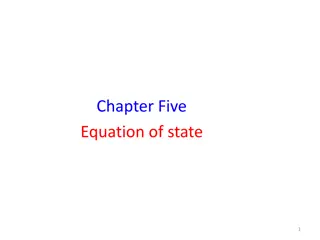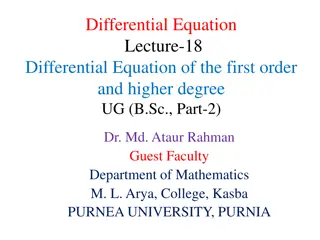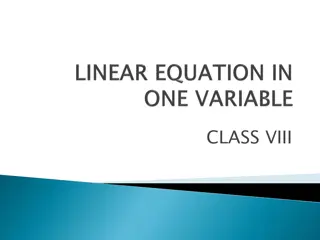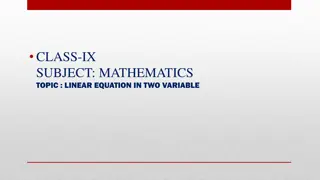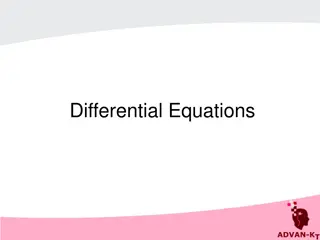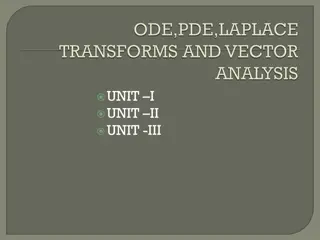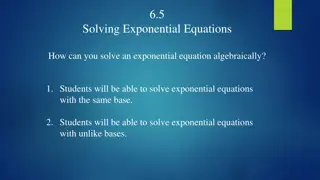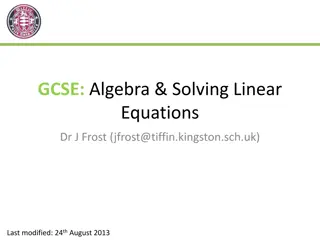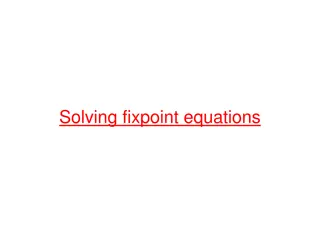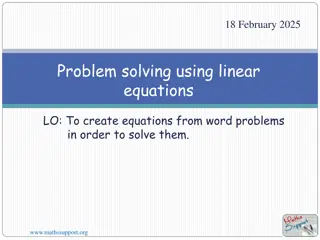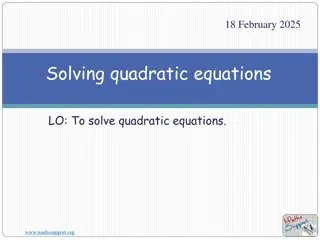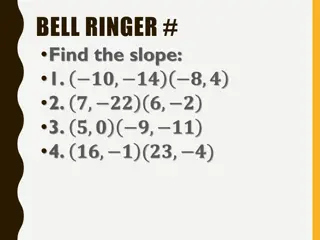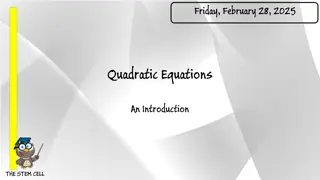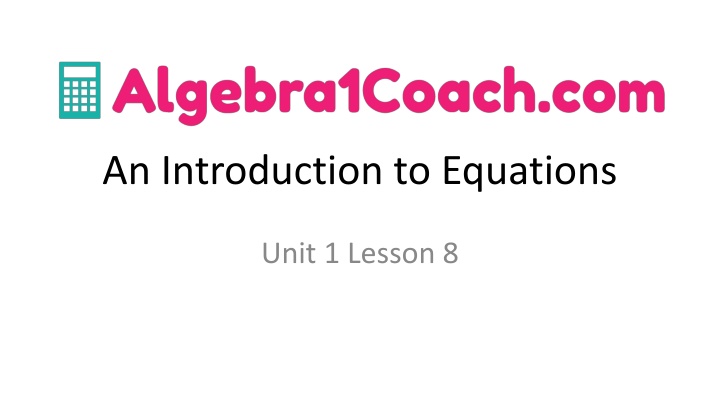
Introduction to Equations: Understanding Mathematical Relationships
Explore the concept of equations, learn to solve them, and check solutions. Understand types of equations, such as true, false, and open sentences. Practice identifying solutions to equations in this informative lesson.
Uploaded on | 1 Views
Download Presentation

Please find below an Image/Link to download the presentation.
The content on the website is provided AS IS for your information and personal use only. It may not be sold, licensed, or shared on other websites without obtaining consent from the author. If you encounter any issues during the download, it is possible that the publisher has removed the file from their server.
You are allowed to download the files provided on this website for personal or commercial use, subject to the condition that they are used lawfully. All files are the property of their respective owners.
The content on the website is provided AS IS for your information and personal use only. It may not be sold, licensed, or shared on other websites without obtaining consent from the author.
E N D
Presentation Transcript
An Introduction to Equations Unit 1 Lesson 8
AN INTRODUCTION TO EQUATIONS Students will be able to: solve equations and check solutions and solve equations using tables and mental math. Key Vocabulary: Defining a variable Four-step problem solving plan Formula
AN INTRODUCTION TO EQUATIONS EQUATION is a mathematical sentence that uses an equal sign (=). It can be used to represent the relationship between two quantities that have the same value. TYPES True equation If the expressions on either side of the equal sign are equal. ? + ? = ?? ?? + ? = ? + ?
AN INTRODUCTION TO EQUATIONS TYPES False equation If the expressions on either side of the equal sign are not equal. ? + ? = ?? ?? + ? = ? + ? Open Sentence If the equation contains one or more variables, and maybe a true or a false depending on the values of its variables. ? + ? = ?? ? + ? = ??
AN INTRODUCTION TO EQUATIONS Sample Problem 1: Tell whether each equation is true, false, or open. Explain. A. ?? + ?? = ?? + ?? B. ? ? = ?? C. ?? + ?? = ??
AN INTRODUCTION TO EQUATIONS Sample Problem 1: Tell whether each equation is true, false, or open. Explain. A. ?? + ?? = ?? + ?? ?? = ?? True B. ? ? = ?? False ?? ?? C. ?? + ?? = ?? Open variable ?
AN INTRODUCTION TO EQUATIONS SOLUTION OF AN EQUATION containing a variable is a value of the variable that makes the equation true.
AN INTRODUCTION TO EQUATIONS Sample Problem 2: Tell whether the given number is a solution of each equation. A. Is ? = ? a solution of the equation ? ?? = ?? B. Is ? =? ?a solution of the equation ?? + ? = ??? C. Is ? = ? a solution of the equation ?? ? = ???
AN INTRODUCTION TO EQUATIONS Sample Problem 2: Tell whether the given number is a solution of each equation. A. Is ? = ? a solution of the equation ? ?? = ?? ? = ?? + ? ? = ?? B. Is ? =? ?a solution of the equation ?? + ? = ??? ? ? ? ? ?? = ?? ? ?? = ? ? = ? ? C. Is ? = ? a solution of the equation ?? ? = ??? ?? = ?? + ? ?? = ?? ? = ? ? ?
AN INTRODUCTION TO EQUATIONS Sample Problem 3: Find the solution of each equation. A. ?? ? = ?? B. ?? = ?? ??? C. ?? ?? = ?
AN INTRODUCTION TO EQUATIONS Sample Problem 3: Find the solution of each equation. A. ?? ? = ?? ?? = ?? + ? ?? = ?? ? = ? B. ?? = ?? ??? ?? ?? = ??? ?? = ??? ? = ? C. ?? ?? = ? ?? = ? + ?? ?? = ? ? = ?
AN INTRODUCTION TO EQUATIONS Sample Problem 4: Use a table to find the solution of each equation. A. ?? + ?? = ?? B. ?? + ?? = ?? C. ?? = ?? + ?
AN INTRODUCTION TO EQUATIONS Sample Problem 4: Use a table to find the solution of each equation. A. ?? + ?? = ?? ? = ? ? ?? + ?? = ?? ? ? ? + ?? = ?? ?? + ?? = ?? ?? ?? ? ? ? + ?? = ?? ?? + ?? = ?? ?? ?? ? ? ? + ?? = ?? ?? + ?? = ?? ?? = ?? ? ? ? + ?? = ?? ?? + ?? = ?? ?? ??
AN INTRODUCTION TO EQUATIONS Sample Problem 4: Use a table to find the solution of each equation. B. ?? + ?? = ?? ? = ? ? ?? + ?? = ?? ? ? ? + ?? = ?? ? + ?? = ?? ?? = ?? ? ? ? + ?? = ?? ?? + ?? = ?? ?? ?? ? ? ? + ?? = ?? ?? + ?? = ?? ?? ??
AN INTRODUCTION TO EQUATIONS Sample Problem 4: Use a table to find the solution of each equation. C. ?? = ?? + ? ? = ? ? ?? = ?? + ? ? ?? = ? ? + ? ?? = ? + ? ?? = ?? ? ?? = ? ? + ? ?? = ? + ? ?? ?? ? ?? = ? ? + ? ?? = ?? + ? ?? ??
AN INTRODUCTION TO EQUATIONS Sample Problem 5: Use a table to find two consecutive integers between which the solution lies. A. ?? ?? = ?? B. ?? + ? = ?? C. ? = ? ??
AN INTRODUCTION TO EQUATIONS Sample Problem 5: Use a table to find two consecutive integers between which the solution lies. A. ?? ?? = ?? ? < ? < ? ? ?? ?? ? ? ? ?? ?? ?? ?? ? ? ? ?? ?? ?? ?? ? ? ? ?? ?? ?? ??
AN INTRODUCTION TO EQUATIONS Sample Problem 5: Use a table to find two consecutive integers between which the solution lies. B. ?? + ? = ?? ?? < ? < ?? ? ?? + ? ?? ? ?? + ? ?? + ? ?? ?? ? ?? + ? ?? + ? ?? ?? ? ?? + ? ?? + ? ??
AN INTRODUCTION TO EQUATIONS Sample Problem 5: Use a table to find two consecutive integers between which the solution lies. C. ? = ? ?? ? < ? < ? ? ? ?? ? ? ? ? ? + ? ? ? ? ? ? ? + ? ? ? ? ? ? ? + ? ?
AN INTRODUCTION TO EQUATIONS Sample Problem 6: Find the solution of each equation using mental math or table. If the solution lies between two consecutive integers, identify those integers. A. ?? ? = ?? B. ?? = ? + ? C. ? = ?? ??
AN INTRODUCTION TO EQUATIONS Sample Problem 6: Find the solution of each equation using mental math or table. If the solution lies between two consecutive integers, identify those integers. A. ?? ? = ?? ? < ? < ? ? ?? ? ? ? ? ? ?? ? ?? ? ? ? ? ?? ? ?? ? ? ? ? ?? ? ??
AN INTRODUCTION TO EQUATIONS Sample Problem 6: Find the solution of each equation using mental math or table. If the solution lies between two consecutive integers, identify those integers. B. ?? = ? + ? ? = ? ? ? + ? ? ? + ? ?? ? + ? ? ? + ? ?? ? + ?
AN INTRODUCTION TO EQUATIONS Sample Problem 6: Find the solution of each equation using mental math or table. If the solution lies between two consecutive integers, identify those integers. C. ? = ?? ?? ? < ? < ? ? ?? ?? ? ?? ? ? ?? ? ?? ? ?? ? ? ?? ?? ? ? ?? ? ? ?? ?? ?
AN INTRODUCTION TO EQUATIONS TRANSLATING SENTENCES TO EQUATIONS: 1. Use variables to represent the unspecified numbers or measures referred to in the sentence or problem. 2. Write the verbal expressions as algebraic expressions. Verbal Expressions that suggest the equals sign: is equal to is is as much as equals is the same as is identical to
AN INTRODUCTION TO EQUATIONS Sample Problem 7: Write an equation for each sentence. A. Fifteen times the number ? is equal to four times the sum of ? and ?. B. Three times ? subtracted from 57 equals 29. C. The difference of 10 and a number is 5.
AN INTRODUCTION TO EQUATIONS Sample Problem 7: Write an equation for each sentence. A. Fifteen times the number ? is equal to four times the sum of ? and ?. ?? ? = ? ? + ? B. Three times ? subtracted from 57 equals 29. ?? ?? = ?? C. The difference of 10 and a number is 5. ?? ? = ?


